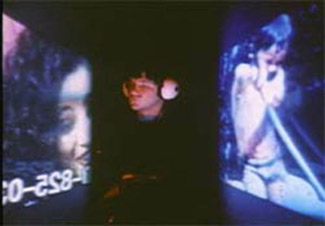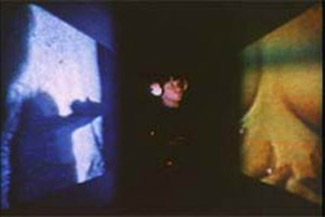
| Material Cinema | The Monadic Institute | Audio-Visual Abuse & Filmocology | Film Affects | Rampant Technology | Links |

Institute's journal Kino Gun (#2)
We at the Monadic Institute have been experimenting with various methods to counter audio-visual hypnosis. Our researchers and practitioners understand that these efforts are only supplementary to our broader charter. Below, we will present one of the most remarkable creations of our experimental therapy researchers, The Staticose Chamber. Before describing the invention, groundbreaking revelations in monadic and cinematic climatology and image penetration must first be discussed. [Go to "Preliminaries to the Staticose Chamber"]
How The Staticose Chamber Works
[From the "Update" section of The Monadic
Institute's journal Kino Gun (#2)]
The Staticose Chamber is an apparatus which works to reverse audio-visual indoctrination, hypnosis, and addiction. It is designed to efficiently utilize sound and image combinations in order to stimulate "interactively". In other words, the device does not induce semi-conscious states, but rather works to bring about clarity, a re-connection and renewed fascination with, or interest in, the "real".
Evaluation and Preparation
Before proceeding with the treatment, the first step is to consult with the subject about their history and current situation. For example, we must evaluate the amount and type of audio-visual consumption/addiction they are struggling with (be it post-work/evening "brain drain" or addiction to pornography...). We ask that the subject refrain from watching films or television for at least the first month of treatment. If the case is particularly severe, we also ask that the subject not read newspapers, magazines, or listen to the radio though reading books of fiction, history, etc. is generally permitted. This is because we have found that keeping up with "current" events is often part of the dilemma and can add aggravating layers of anxiety. This sort of stress appears to stem from the persistent reminders of a fleeting present within which the subject does not feel included. In this sense, the "current" of current events can be thought of as exactly that, a sort of unnatural undercurrent which drags some people out to a sea of disorientation where the only sense of security is found in audio-visual consumption which is always just shy of satisfying. In short, the one of the goals of the Staticose Chamber is to create a positive relationship with information absorption in general through sound and image therapy.
The Sensory Sled
The Chamber has at its disposition a wide number of variables which enable it to reformulate conventional viewing configurations in a modular fashion. The traditional viewing experience is altered, breaking the patterns the subject has become accustomed to. Technically speaking, we constructed several sets of video panels, eight feet high and of varying widths. These panels are then lined up to make a non-linear hallway of video with dark intervals in between the sets which are altered for each subject. Subjects are placed on the sled which smoothly moves down the hall. The sled slows and sometimes halts in between the different sets which each deal with certain aspects of the subject's situation. Captors placed on the subject assist the researchers to gauge these adjustments. The sounds and images which are orchestrated according to the subject's psychological profile are subject to variations in speed (frames per second) and intensity (editing pace on each screen). In some cases, we also employ smell in the Chamber or attach other stimulation devices to the sled. These are not altogether new techniques, filmmakers such as William Castle, John Waters (smellorama), or Maurice Lemaitre have all brought other senses into play.
Case Study: Addiction to Pornography
One common example of a treatable audio-visual problem is addiction to pornography. Here is part of our procedure as it applied to one case in particular. On one of the panel sets, the subject was confronted with images of pornography while on the other, these images were progressively intercut with his own childhood home movies until the two sides were each totally distinct. This was carried out over a period of several sessions. Eventually, a choice was made between the "purer" childhood images and the images which had polluted him. The sound began in such a way that when he would look at the home movies he would hear the pornographic soundtrack and when he would look at the pornography he would hear the home movie soundtrack. For the subject in question, this created an intense conflict. The sound slowly switched over, after the panels had become distinct, so that he heard the appropriate sound for each set of images. This helped his resolution process. There were six sets of panels, the others varied in content and parameters depending on the results of the most recent visit. For example, one set juxtaposed scenery resembling what the subject described fondly having experienced as a child and on the other screen landscapes he was captivated by as an adult. There is no formula which works on everybody and the results are not guaranteed. In this case however, after five visits we were successfully able to disinterest the subject from pornography and improve his quality of life and thus those he had contact with.
Innoculation
The process is not dissimilar to the principles which apply to inoculations whereby the body is given a reformulated version of the disease itself in order that the body will then create a resistance to it. The Chamber utilizes sound and image with a dialectical precision while leaving space for the subject to determine and interpret meanings, possibilities, and their poetic echoes. Another way to think of this process is to imagine the subject entering a constellation of sound and image in which the positioning of the bright points creates lines, shapes, intersections, and movements which speak to the subject and create a dialogue with him or her. There is no fixed structure or system to our use of sound and image in the Staticose Chamber. Within a familiar lexicon, it proposes alternatives to thought patterns/structures which the subject had been conditioned to and aligned with.
To better understand the nature of The Staticose Chamber, it is best to see it in action. We have made a short film which demonstrates the Chamber [1996] which we hope will provide a better idea of how it operates.
Download The Staticose Chamber here - for a full-quality version, contact Material Cinema
During the final period of the Monadic Institute, the filmmaker James Schneider took a keen interest in the institute's activities and was asked to document the audiovisual therapy device, the Staticose Chamber (1996) (read below). The film and the device it documented became a crucial inspiration for the film Eternal Sunshine of the Spotless Mind (2004) directed by Michel Gondry (with Jim Carrey). This is just one of many examples whereby The Monadic Institute has had an impact on mainstream culture.
For more on filmmaker James Schneider go to: jamesjune.info

Preliminaries to The Staticose Chamber
When the passively seated observer engages with a film in a conventional cinema or television at home, they are often induced into a semi-comatose state. By engaging with as many stimuli as possible (eating, drinking, watching and listening) the subject employs between two and five of his senses in the experience. The simultaneous intake of so many stimuli creates a satiating numbness which renders the subject far more willing to absorb what is being presented. Sight, the primary sense, is completely absorbed while the other senses rein in and anchor the captured vision. Depending on the conditions, the subject may attain a womb-like feeling as the comfort of the many possible stimuli come into play: smell, feel, and taste of the food and drink, the representations on the screen, the voices and sounds, the darkness of the theater [...]

While we understand that there are times when we need to "turn off", it is the damage which occurs when we deliver ourselves to films and television programs that concerns us. The ad-infinum repetition of the same basic narrative structures(ex: expectation and reward) and redundancy of filmic language (compositions, movements...) has clearly been shown to be damaging to mental health. Repetition is well established as the foundation of various brainwashing techniques. The "tuning in" to repetitive modes of thought and belief systems is one of the most preoccupying problems for the Institute. Our research seems only to confirm long held suspicions about what happens when the intake of television is too high and when it becomes habit [...]. Brain scans performed on subjects while they watched action films such as Missing in Action or Megaforce or dramas of similar quality show that the brain activity was on an average of 30% closer to sleep levels than to waking levels. A similar experiment was done with televised evening police dramas such as Kojak and the results were similar. Tests compiled from a wide demographic indicate that this effect does not vary significantly for different social or ethnic groups [...]
We are troubled with the idea of a world where audio-visual hypnosis works in tandem with other destructive forces of society [...] Our recent studies are the latest step in working towards confronting the destructive apsects of contemporary audio-visual consumption. Children who have been raised on and by television more than by their own parents have been conditioned for a life at the whim of these sounds and images. As the "mirror phase" of Jacques Lacan speaks to the idea of a fragmentary body unified in image for the child, so does the perfected image on the screen portray a fragmented body and world as perfected. Be it television or cinema, the parade of unattainable perfection ingrains and pixellates itself into the gray matter. Conversations become plagued with tele-talk and references homogenize as colorful life which should be celebrated for its intensity begins to appear drab in contrast. Critical capacities are softened and the lack of presence in "real" life settles in. What may have begun as casual entertainment transforms into a false need.
From its outset, television never had as a project to improve lives; we find its direction disturbing. The apparent trend in television and cinema seems to be a veering astray from the opening of dialogues, opening of spirits, away from creating beautiful experiences which transcend and reveal such as some of the great "experimental" filmmakers have attempted to do. While of course there are exceptions, for many people the relationship with images and sound has become something of a disease, an opiate which hijacks lived experience. The members of the Monadic Institute feel that while understanding the situation is paramount, it is not enough, we must simultaneously create alternatives as well as means of countering this hypnotic tide.
back to top